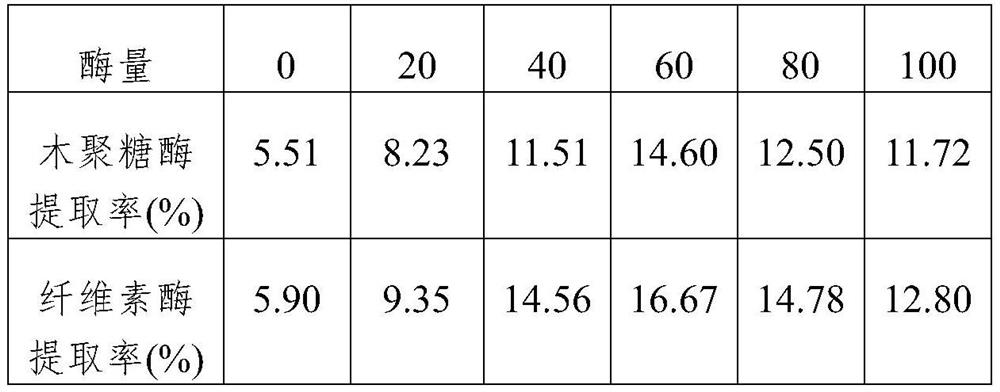Bioenzyme-method extraction process for extracting pectin from papaya peel
A biological enzyme method and extraction technology, applied in the field of food deep processing, can solve the problems of papaya pectin that has not been reported, and achieve the effects of improving comprehensive utilization value, reducing environmental pollution, and increasing farmers' income
- Summary
- Abstract
- Description
- Claims
- Application Information
AI Technical Summary
Problems solved by technology
Method used
Image
Examples
Embodiment 1
[0095]A bio-enzymatic extraction process of pectin in papaya peel, adding papaya peel powder into buffer solution, preheating in a constant temperature water bath, adding compound enzyme, stirring for enzymatic hydrolysis, centrifuging, adding ethanol to the supernatant and standing still for alcohol analysis , and then through vacuum filtration and drying, to obtain the pectin; specifically comprising the following steps:
[0096] (1) Preparation of papaya peel powder: select the papaya peel that has just been peeled off, remove pulp, impurities, mildew, and rotten papaya peel, decoct in boiling water to passivate, then rinse and cool with distilled water, then soak in distilled water, repeat Wash and remove part of the soluble sugar on the papaya skin, remove it and put it on a bamboo basket to drain the water, chop it and put it in an electric constant temperature blast drying oven to dry, crush it, sieve it, and dry it for later use;
[0097] The passivation temperature is...
Embodiment 2
[0102] A bio-enzymatic extraction process of pectin in papaya peel, adding papaya peel powder into buffer solution, preheating in a constant temperature water bath, adding compound enzyme, stirring for enzymatic hydrolysis, centrifuging, adding ethanol to the supernatant and standing still for alcohol analysis , and then through vacuum filtration and drying, to obtain the pectin; specifically comprising the following steps:
[0103] (1) Preparation of papaya peel powder: select the papaya peel that has just been peeled off, remove pulp, impurities, mildew, and rotten papaya peel, decoct in boiling water to passivate, then rinse and cool with distilled water, then soak in distilled water, repeat Wash and remove part of the soluble sugar on the papaya skin, remove it and put it on a bamboo basket to drain the water, chop it and put it in an electric constant temperature blast drying oven to dry, crush it, sieve it, and dry it for later use;
[0104] The passivation temperature i...
Embodiment 3
[0109] A bio-enzymatic extraction process of pectin in papaya peel, adding papaya peel powder into buffer solution, preheating in a constant temperature water bath, adding compound enzyme, stirring for enzymatic hydrolysis, centrifuging, adding ethanol to the supernatant and standing still for alcohol analysis , and then through vacuum filtration and drying, to obtain the pectin; specifically comprising the following steps:
[0110] (1) Preparation of papaya peel powder: select the papaya peel that has just been peeled off, remove pulp, impurities, mildew, and rotten papaya peel, decoct in boiling water to passivate, then rinse and cool with distilled water, then soak in distilled water, repeat Wash and remove part of the soluble sugar on the papaya skin, remove it and put it on a bamboo basket to drain the water, chop it and put it in an electric constant temperature blast drying oven to dry, crush it, sieve it, and dry it for later use;
[0111] The passivation temperature i...
PUM
 Login to View More
Login to View More Abstract
Description
Claims
Application Information
 Login to View More
Login to View More - R&D
- Intellectual Property
- Life Sciences
- Materials
- Tech Scout
- Unparalleled Data Quality
- Higher Quality Content
- 60% Fewer Hallucinations
Browse by: Latest US Patents, China's latest patents, Technical Efficacy Thesaurus, Application Domain, Technology Topic, Popular Technical Reports.
© 2025 PatSnap. All rights reserved.Legal|Privacy policy|Modern Slavery Act Transparency Statement|Sitemap|About US| Contact US: help@patsnap.com



